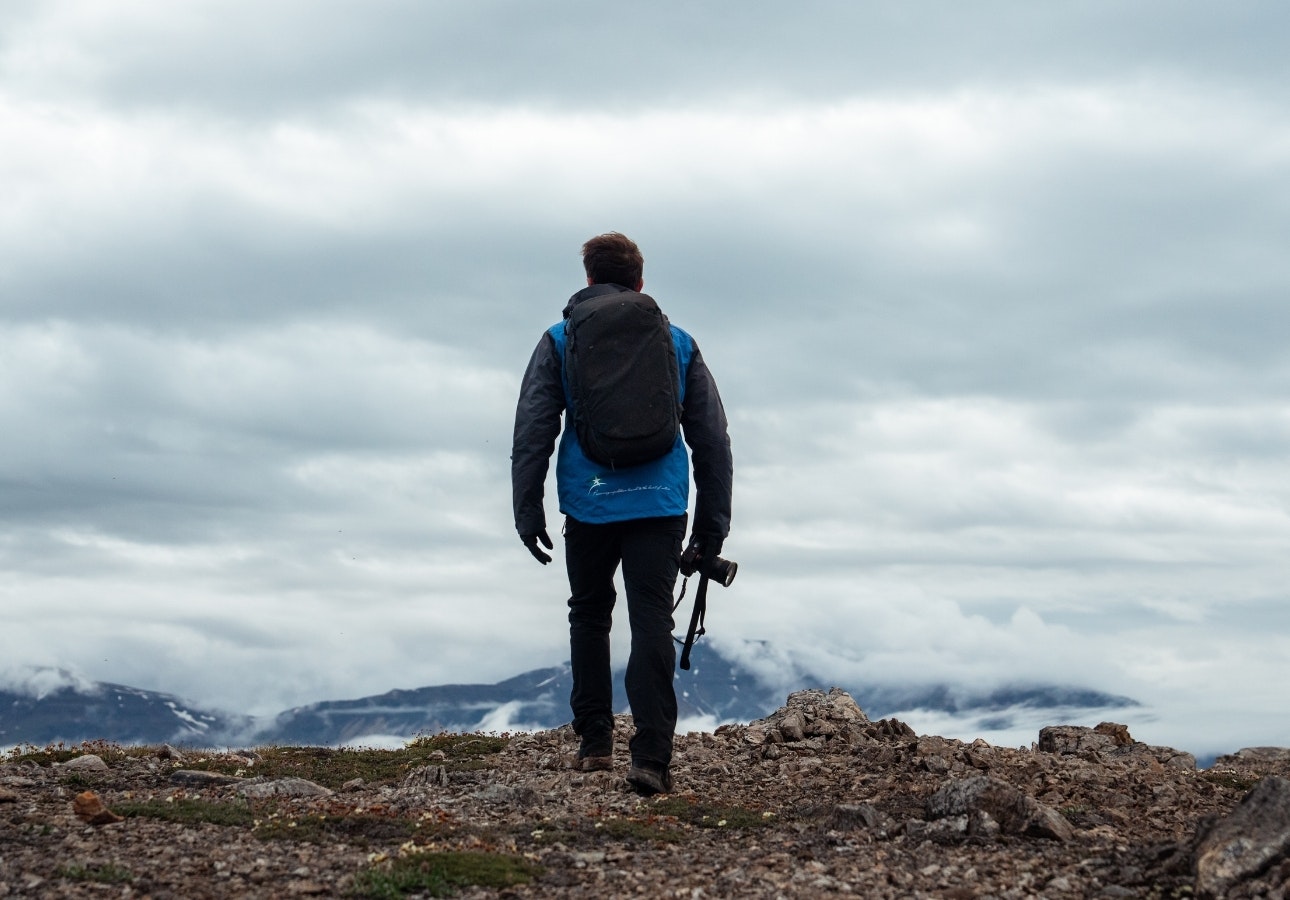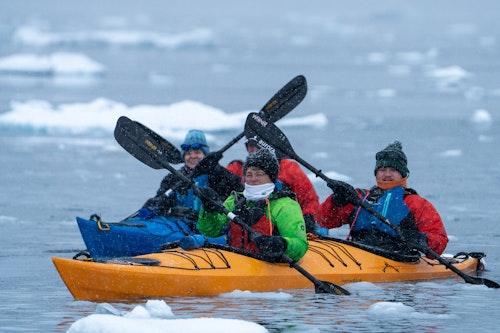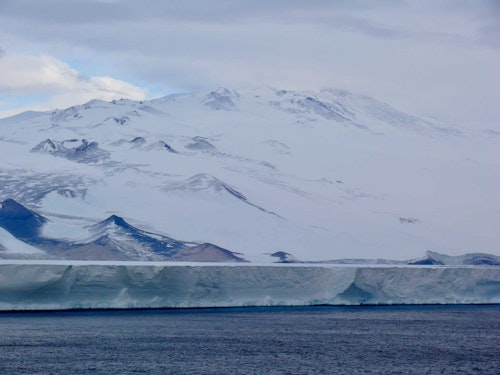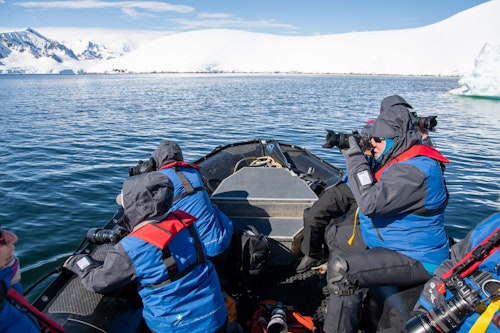Embrace the spirit of adventure as you navigate narrow channels full of pack ice and breathtaking ice sculptures, allowing nature to dictate your itinerary.
Few are lucky and privileged enough to tick the elusive 7th continent off their travel bucket list, and even fewer are afforded the opportunity to cross the Antarctic Circle. Going over the imaginary line at 66°33’ south is a memorable occasion for expeditioners, celebrated with a toast out on the deck. However, it’s not just about earning bragging rights. It’s about being offered a glimpse of an elemental wilderness that is rarely visited – a world that’s colder, rawer and wilder.
Take advantage of endless days to watch for feeding whales alongside your expedition ship, visit bustling penguin colonies, hike to remote vantage points for panoramic views of the surrounding landscape, Zodiac cruise through mirror-like waters and take in scenes of ice-clad mountains.
-(1290-x-900-px)-(2).jpg?language=en&auto=format&w={width}&fit=cover)
Unforgettable Antarctic Circle Experiences
Crossing the Antarctic Circle
Earn some serious boasting privileges as you cruise across the Antarctic Circle, an imaginary line at 66° 33’ south. Raise a glass in a toast as you join a small group of lucky adventurers who have ventured to this remote part of the world.
Embarking on Antarctica Circle cruises offers a once-in-a-lifetime opportunity to explore one of the most remote and untouched corners of the planet. As you journey through the icy waters, you’ll have the chance to witness some of the most spectacular scenery on Earth, from towering icebergs to majestic glaciers and snow-capped peaks.
Incredible Wildlife
Antarctica is a unique destination for wildlife enthusiasts as it is home to an incredible range of marine mammals, penguins, seals, and seabirds. In addition to the petit Adélie penguins, visitors to the Antarctic Circle might also encounter other species of penguins. These charming birds are often found in large colonies, with thousands of individuals waddling, jumping and diving into the icy waters.
Visitors to the Antarctic Circle can witness an incredible range of wildlife, each with its unique adaptation to life in this extreme environment of the polar regions.
Immersive Activities
Explore the Antarctic Circle with a variety of included and optional activities on an Aurora Expedition cruise. Onshore, enjoy guided hikes, wildlife encounters, historic site visits and bird watching as you discover the Antarctic terrain. While ashore participate in our Zodiac cruises, explore local bays and enjoy the adrenaline-filled polar plunge! A time-worn tradition, the polar plunge is a rite of passage into an exclusive club. Onboard, enjoy informative lectures, wildlife watching, and access to gym, sauna, and spa facilities.
Optional activities include sea kayaking, scuba diving, snorkelling, stand-up paddleboarding, snowshoeing, ski and snowboard touring, climbing and alpine trekking, and polar camping, making your adventure truly unforgettable.
Explore Ashore
Brace yourself for sizable Adélie penguin rookeries, and large tabular icebergs that have drifted north as you start your Antarctic expedition cruise. After crossing the Antarctic Circle, Detaille Island is a spectacular location that will be imprinted on your memory, if you are lucky enough to visit. Its snowy peaks soar more than 2,000 metres above the ice-strewn waters.
Conditions permitting, expeditioners may have a chance to explore the abandoned bases of Stonington Island. At 68 degrees south, it’s the furthest point ships will ever visit on a southern expedition. Add your name to the visitor’’s book and look back to see just how few people are able to visit each year.
Antarctic Circle Cruises FAQs
The Antarctic Circle is celebrated as a remarkable destination due to its status as one of the most remote and untouched corners of the planet. Cruising across this latitude line offers a once-in-a-lifetime opportunity to explore the pristine beauty of the Antarctic region. From towering icebergs to majestic glaciers, this region boasts spectacular scenery that captivates and inspires adventurers seeking a truly extraordinary experience.
The cost of a cruise to the Antarctic Circle varies depending on factors such as the duration of the expedition, stateroom type, and the specific itinerary you choose. Once you choose your Antarctic Circle cruise, you will have options for various stateroom types and additional activities. Explore our offerings to find the perfect Antarctic Circle cruise that suits your preferences and budget.
The Antarctic Circle is an imaginary line located at 66° 33’ south latitude, marking the southernmost point where the sun remains above the horizon for 24 continuous hours at least once per year. This latitude line signifies the boundary beyond which travelers can embark on an extraordinary journey into the remote and pristine wilderness of the even-less-visited parts of Antarctica.
The ideal time to embark on an Antarctic Circle expedition is during the austral summer, typically spanning from early October to late March. This season ensures milder weather conditions and extended daylight hours, providing optimal opportunities to explore the Antarctic Circle’s unique landscapes, wildlife, and historical sites.
When preparing for an Antarctic Circle cruise, pack essentials such as layered clothing, waterproof gear, and sturdy, insulated boots. Shipboard attire is informal – we recommend jeans, long pants, long-sleeved shorts and jumpers for indoors and to wear under your complimentary expedition jacket. Consult our suggested packing list for detailed guidance on the types of layers and materials suitable for the Antarctic environment. Remember to include a camera to capture the mesmerizing landscapes and wildlife encounters during your Antarctic Circle expedition. View our suggested packing list, which covers the types of clothing and accessories we recommend.
Antarctica is a haven for wildlife enthusiasts, offering encounters with a diverse range of marine mammals, penguins, seals, and seabirds. Within the Antarctic Circle, Adélie penguins, gentoo penguins, chinstrap penguins, seals such as Weddell seals, leopard seals, crabeater seals, and elephant seals, as well as various seabird species like albatrosses and petrels, contribute to the remarkable wildlife spectacle that awaits expeditioners. Each Antarctic Circle crossing promises extraordinary wildlife encounters, providing a truly unmatched experience.
The Antarctic Circle encompasses the vast and icy expanses of Antarctica, it is between the Southern Temperate Zone and the Antarctic continent. This imaginary line is situated at 66° 33’ south latitude, encircling the continent.
Crossing this threshold opens the door to an unparalleled adventure into one of the most untouched and extraordinary landscapes on Earth.
Joining an Antarctic Circle Expedition Cruise promisesis an unparalleled voyage of discovery that grants exclusive access to the rarely seen and isolated regions beyond the Antarctic Circle. This adventure offers a chance to witness breathtaking scenery, colossal icebergs, and thriving wildlife, including penguins, seals, whales, and seabirds. Led by experienced Expedition Guides, the expedition provides insights into polar exploration, Antarctic history, and marine ecosystems, creating an unforgettable and enriching experience.




















